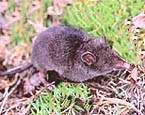9870 St Vincent Place, Glasgow, DC 45 Fr 45.
Род: Lestoros = Перуанские ценолесты

- Класс: Mammalia Linnaeus, 1758 = Млекопитающие
- Инфракласс: Metatheria Huxley, 1880 = Сумчатые
- Отряд: Marsupialia Illiger, 1811 = Сумчатые
- Семейство: Caenolestidae Trouessart, 1898 = Ценолестовые, крысовидные опоссумы
- Род: Lestoros Oehser, 1934 = Перуанские ценолесты
- Вид: Lestoros inca Thomas = Перуанский ценолест
Род: Lestoros Oehser, 1934 = Перуанские ценолесты
Род перуанских ценолестов=Lestores Owen, 1934
В роде единственный вид: перуанский ценолест — L. inca Thomas, 1917. Окраска длинного меха типичная для семейства. Сосков 4. Верхний клык короткий, имеет два корня. Экология почти не изучена. Ведет наземный образ жизни. Активность ночная. Питается в основном насекомыми и, возможно, другими беспозвоночными.
Вид: Lestoros inca Thomas = Перуанский ценолест Обитает в Андах на юг до Перу.. Длина тела 10-12 см, длина хвоста 10-12 см. Населяет горные леса до 3500-4200 м над уровнем моря.
Lestoros inca. This species was placed in the genus Caenolestes (Bublitz, 1987) after a study of a large collection found it to be synonymous. Head and body length is 90-135 mm and tail length is from 93-139 mm. Weights average from 25-40.8 g. for males and 16.5-25.4 for females. The pelage is made up of different textures, causing an uneven appearance to the soft, thick fur. The coloration tends to be darker above ranging from dark browns to nearly black. The nonprehensile tail is nearly naked and is the same color as the back. The small ears protrude above the fur and the eyes are very small. The head is elongate like that of a true rat or shrew. L. inca is the best known of all the species. It has five digits on each foot, the forefeet having small outer toes with blunt claws and sharply curved nails on the remaining three. The hind feet have well developed curved claws on all toes but the great toe, which is small with a small nail. L. inca is nocturnal and terrestrial, preferring cool, wet areas with heavy vegetation. They are found in alpine forests and meadow zones of the Andes at altitudes from 1,500-4,000 meters. To travel from one area to another, they build runways through the surface vegetation. The sight of L. inca is poor, but the hearing and sense of smell are well-developed. Long thought to be largely insectivorous, L. inca has been found to easily kill newborn rats. Breeding season is believed to be early July, as specimens trapped in August were suckling young. L. inca is found in the Andes of south-central Peru. http://brainmuseum.org/Specimens/marsupalia/ratonruncho/
